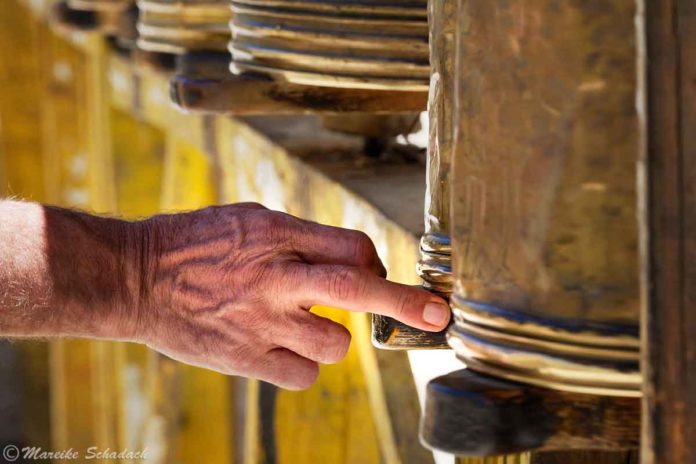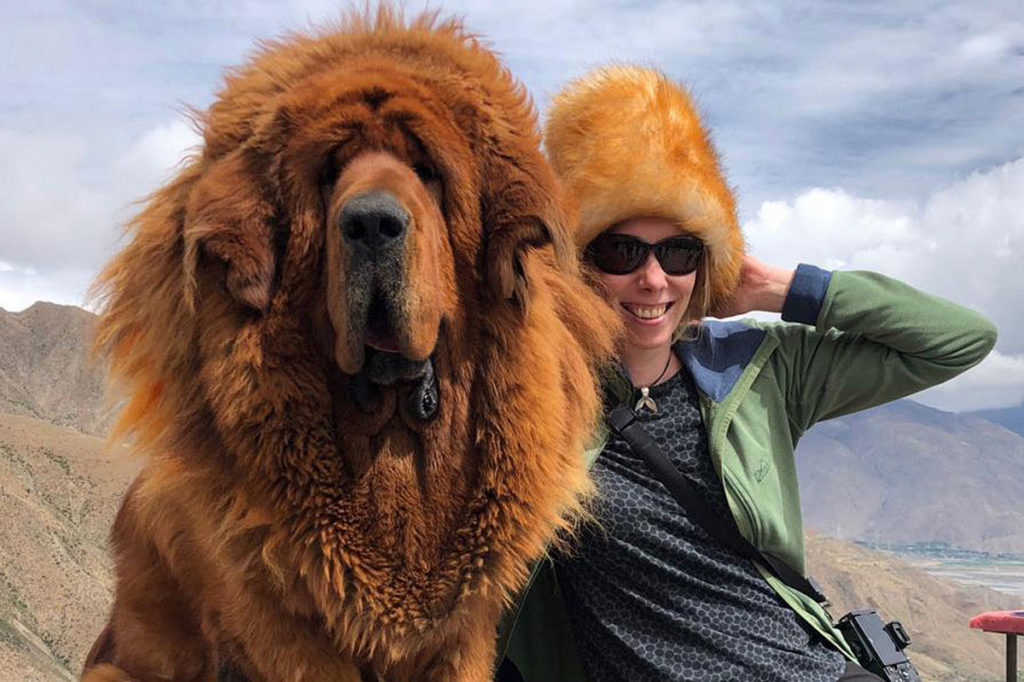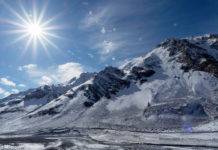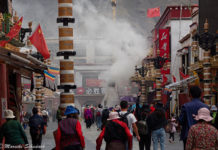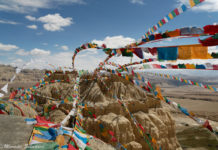China, Tibet. Tibet is also called "the roof of the world", "the third pole" or "the water tower of Asia". The world of monasteries is as diverse as the names for Tibet. But if you are not so deeply rooted in Buddhism, perhaps you will have a similar fate as I have: after the third monastery, the differences become blurred. In my article I would therefore like to tell you what impressed me most about the individual monasteries and what, in my view, makes each individual monastery on the roof of the world unique. You will also find some tips and hints for taking pictures of each monastery.
Non-solicited, unpaid advertising. This article contains affiliate links*, marked with an asterisk.

What awaits you in my Article about the Monasteries in Tibet:
Norbulingka Palace in Lhasa
Sera Monastery near Lhasa
Pelkor Chöde Monastery in Gyantse
The Journey from Lhasa to Shigatse
Sakya Monastery
Mt. Everest and the highest Monastery in the World - Highlights of our China Trip
Dratun Monastery
Drive from Saga to Lake Manasarovar
Chiu Monastery on Lake Manasarovar
Tashilhunpo Monastery
Ganden Monastery - a worthwhile Day Trip from Lhasa
Drak Yerpa Rock Monastery near Lhasa
Norbulingka Palace in Lhasa
The Norbulingka Palace is the summer palace of the Dalai Lama. It was built in the 18th century by the 7th Dalai Lama and has been continuously extended since then. The park includes several ponds, fountains, bridges and many old trees. In 1959, at the age of 23, the 14th Dalai Lama fled from here to exile to India from the Chinese. He was protected by a crowd of people gathered in front of the palace. During the following Cultural Revolution much of the palace and park was destroyed. Since 1994 the palace has been a UNESCO World Heritage Site.

The entrance to the residence is colourfully decorated. Large stone lions stand to the left and right of the portal. Through a garden with a fountain and flowers you can reach the private rooms of the Dalai Lama. A staircase leads you to the reception room for the pilgrims. The walls are decorated with an elaborate and very detailed painting. It tells the story of Tibet from the origin of the Tibetan people up to 1959, according to which the Tibetan people are descended from a rock demoness and the god Chenresi, embodied in the form of a monkey.

Furthermore, the audience room with the golden throne and several of the Dalai Lama's private rooms can be seen. For example the bedroom, the bathroom, the meditation room or the room that was intended for meetings with his mother.
On the ground floor you come to the so-called audience room with a large golden throne. Below this is the oracle room, which we unfortunately could not visit. To the left of the throne, somewhat hidden, hangs the only picture of the Dalai Lama in all of Tibet. It shows him at the age of 24 years. The possession of a picture of the Dalai Lama is forbidden in Tibet today.

Photography in Norbulingka Palace
Photography is permitted only in the outdoor facilities of the Norbulingka Palace. However, the beauty of the outdoor facilities and the Jewel Garden offer you a variety of great motives.
Sera Monastery near Lhasa
Sera Monastery, together with Ganden and Drepung Monastery, is one of the three great monasteries of the Gelug Order in Tibet. A special feature of the monastery is the culture of discussion and religious debate. Visitors of the monastery can watch the monks - one sitting, one standing - debating in pairs from 15:30. It is sometimes lively, with grand gestures and clapping hands. This practice of debating goes back to a Buddha's instruction that one should only accept Buddha's teachings after one's own examination of their truth content.
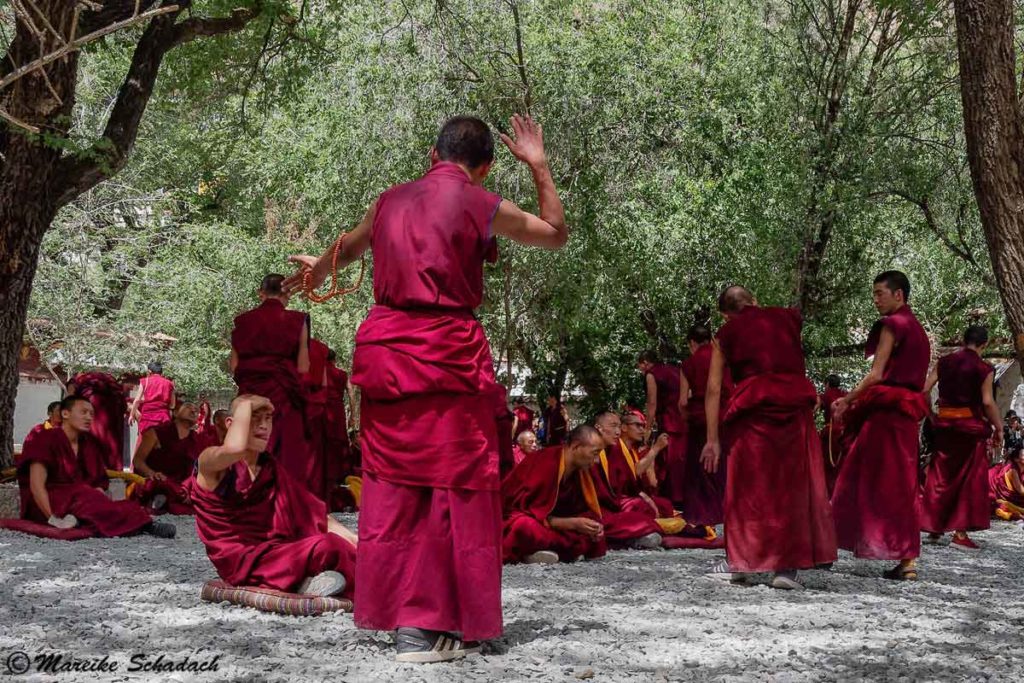
Furthermore, Sera Monastery is known for its large collection of Tibetan scriptures and the printing of texts. In the library you can therefore also buy Tibetan books as souvenirs.
Photography at Sera Monastery
Photography is only allowed outside the buildings. However, for 10 or 20 Yuan, you can also take pictures of the sand mandalas, the bookbindery or the canteen kitchen from inside.

Pelkor Chöde Monastery in Gyantse
The Pelkor Chöde Monastery is located in the city of Gyantse. It is famous for its Kumbum, which is the largest in Tibet with four floors and 108 chapels. Kumbum is the name for a stupa that contains many holy paintings. This one contains over 10,000 murals and many Buddha statues.
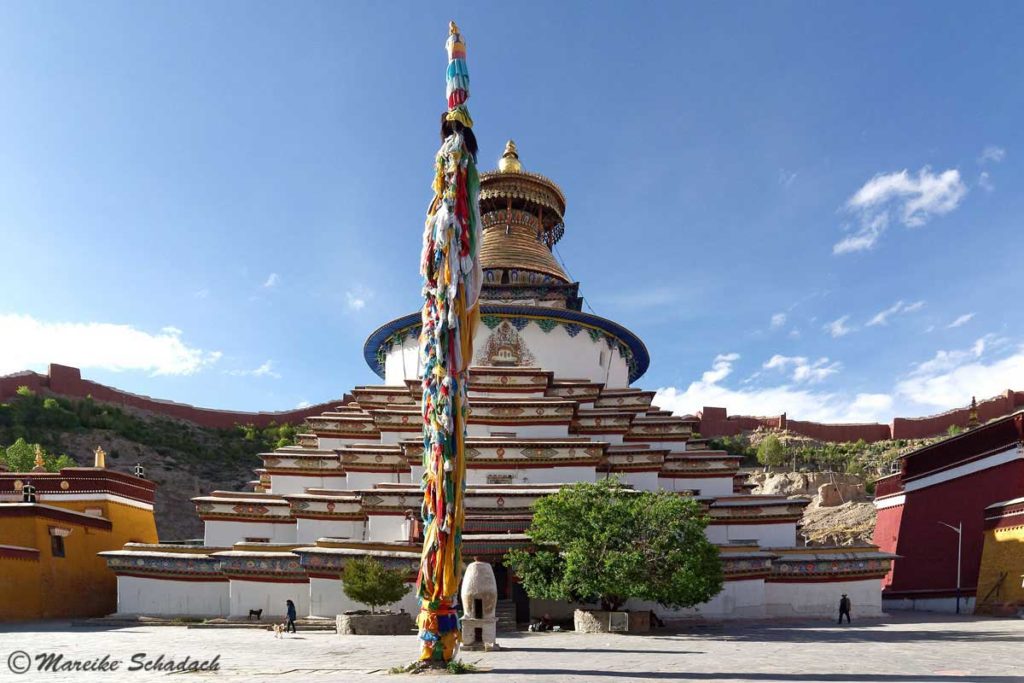
The first buildings of Pelkor Chode Monastery date back to 1427. However, the construction of the famous Kumbum was not started until 1440. In 1904 the monastery was bombarded by the English while they were taking Lhasa. In the course of the Cultural Revolution the monastery was then heavily destroyed. Since 1996 it is on the list of monuments in China.

Photography at Pelkor Chöde Monastery
The murals and figures inside the Kumbum may be photographed. In addition, photography was allowed in the prayer hall and the adjacent chapel for a donation of 20 yuan. The monastery was preparing for the Saga-Dawa Festival. Therefore, it was very decorated and there were especially many offerings.
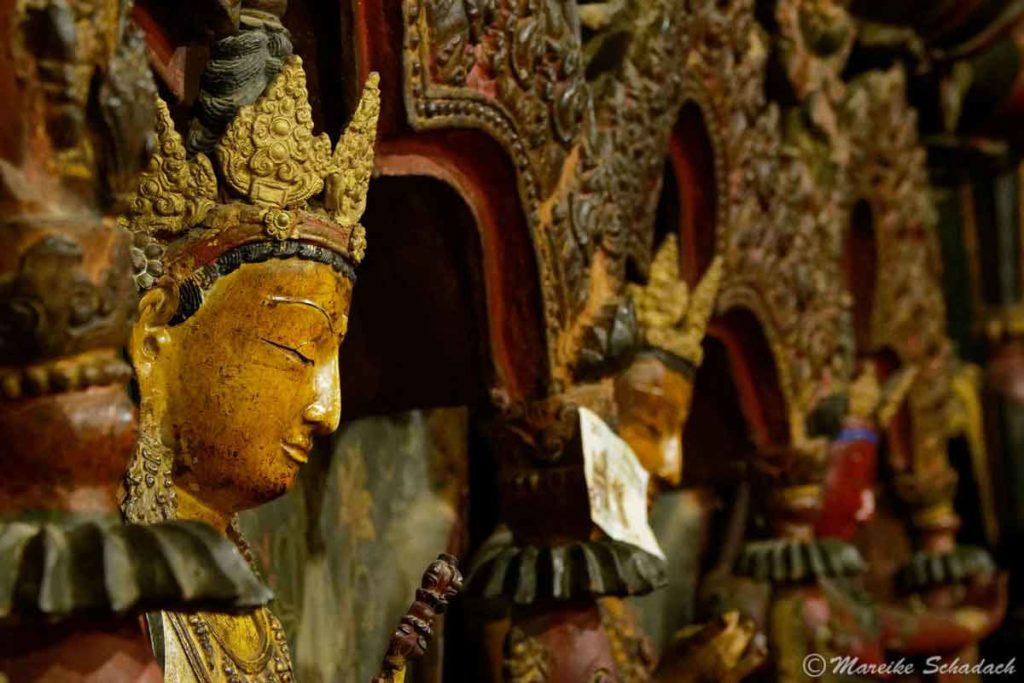
Excursus: Tibet's monasteries during the Cultural Revolution
Before the rebellion in 1959 there are said to have been 2,700 temples and monasteries in Tibet. The so-called "democratic reforms", which were carried out in Tibet by the Chinese government from 1959, reduced the number of temples and monasteries to 550, but after the Cultural Revolution from 1966 to 1978 there were only eight (source: info-buddhismus.de). Since 1978 the monasteries and temples have been restored. Today there are about 1,700 monasteries in Tibet.
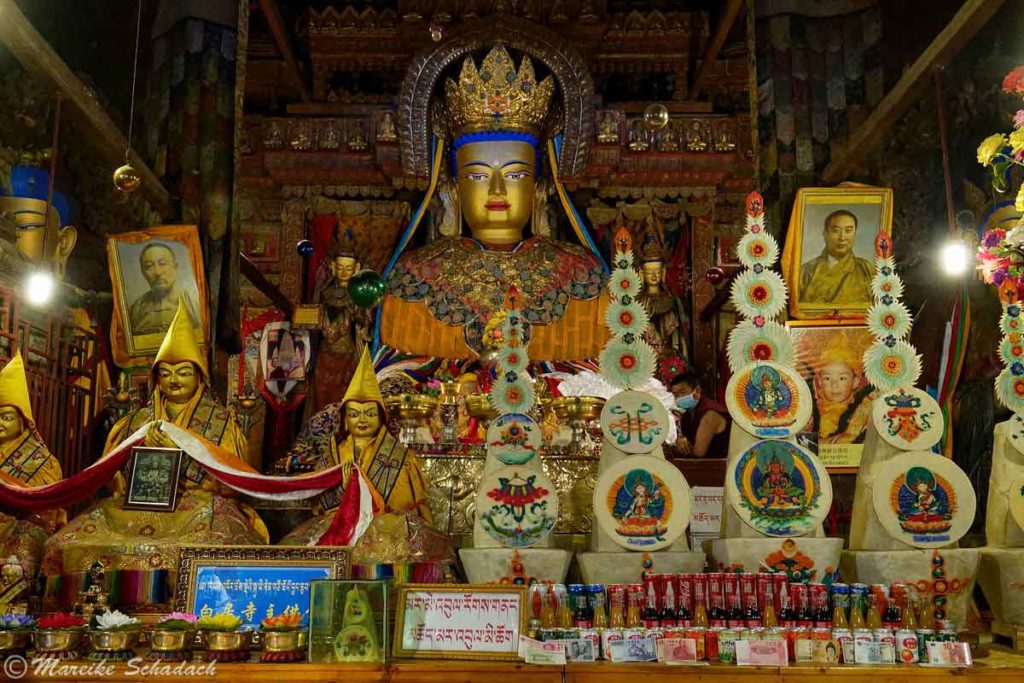
Long tested and much loved: my three companions on photo tours: the lightweight carbon tripod CT-5C I from Rollei*, the cleaning kit from Rollei*and my indestructible camera backpack, the camera backpack, the Flipside from Lowepro*.
The Journey from Lhasa to Shigatse
The landscape changes on the 350 km long way from Lhasa to Shigatse. At first, the route leads over a relatively unspectacular plateau. Then the road begins to wind its way up in serpentines to the Kampa-la Pass (4,797 metres). From here there is a great view of the holy lake Yamdrok-Tso. On the way to Gyantse there are also numerous opportunities for photo shootings with typical Tibetan animals. These include not only the yaks, but also the Tibetan mastiff and kitschily decorated lambs.
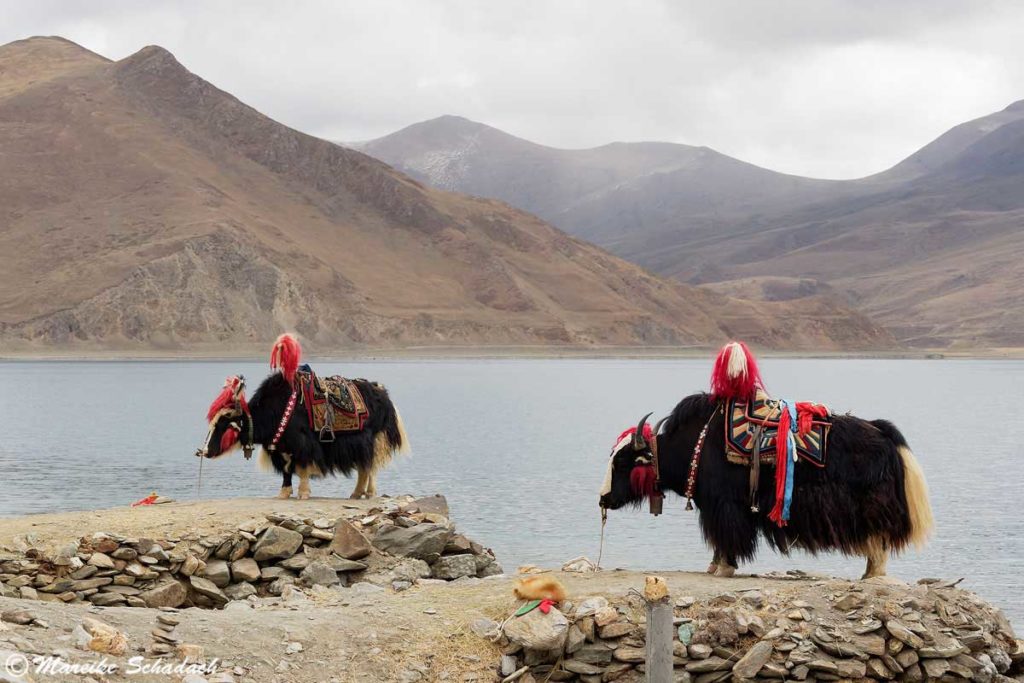
We continue over the even higher Karo-la Pass (5,050 meters) and along a reservoir. The closer we get to Gyantse, the more agriculture and livestock we see: yaks, horses, sheep, cattle. Behind another mountain range, behind which sand dunes spread out, we see extensive reforestation. Because after the intensification of agriculture during the Cultural Revolution, the desertification of the landscape is a big problem in Tibet.
Shigatse calls itself the capital of wheat. Because there are fields all around the city and also along the first part of the route to New Tingri. We also pass through a new settlement with many houses, all looking the same. They are part of a resettlement project of the Chinese government. The Tibetan nomads are to be made sedentary and thus more controllable.
Tibet - the hidden Library in Sakya Monastery
It's dark and cold. Only our mobile phone lamps illuminate the long, narrow corridor behind the large sutra hall. But in the light of our mobile phones we see thousands of books. They pile up to the ceiling. Here I will tell you about the hidden library in Sakya Monastery . You will also learn what other special features you can discover in Sakya Monastery.
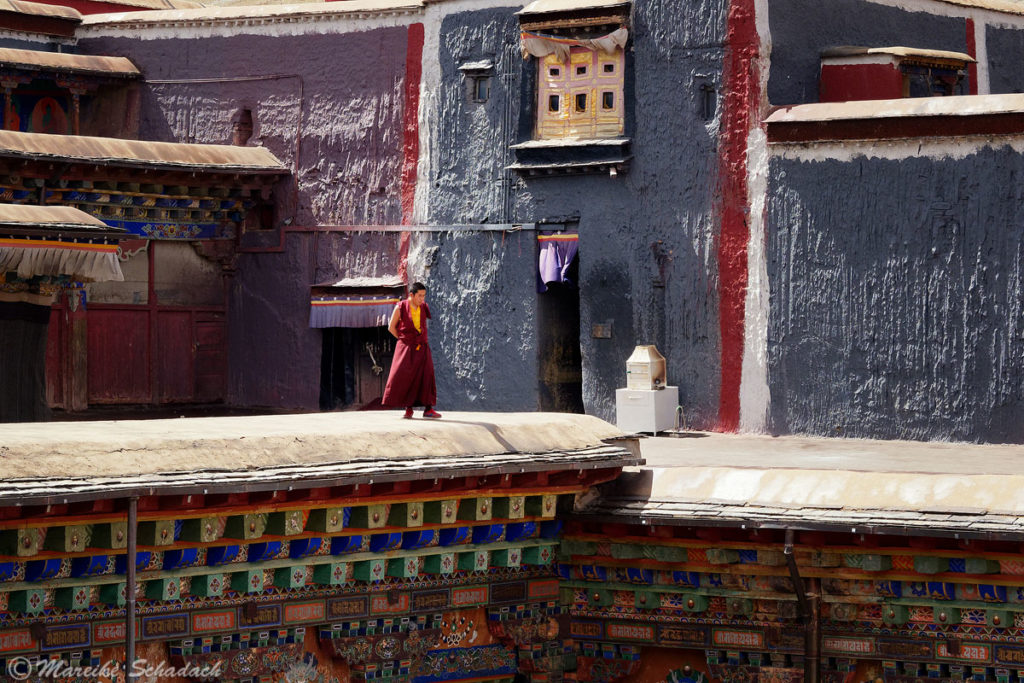
Mt. Everest and the highest Monastery in the World - Highlights of our China Trip
It is a holy mountain, a myth and the dream of many ambitious climbers. But even for non-mountaineers a view of Mt. Everest is an absolute highlight of a trip to China. Here you can find out where you come closest to the northern flank of Mt. Everest. You will also read where the highest monastery in the world is located and which highlights the trip to the Rongbuk Monastery has to offer.
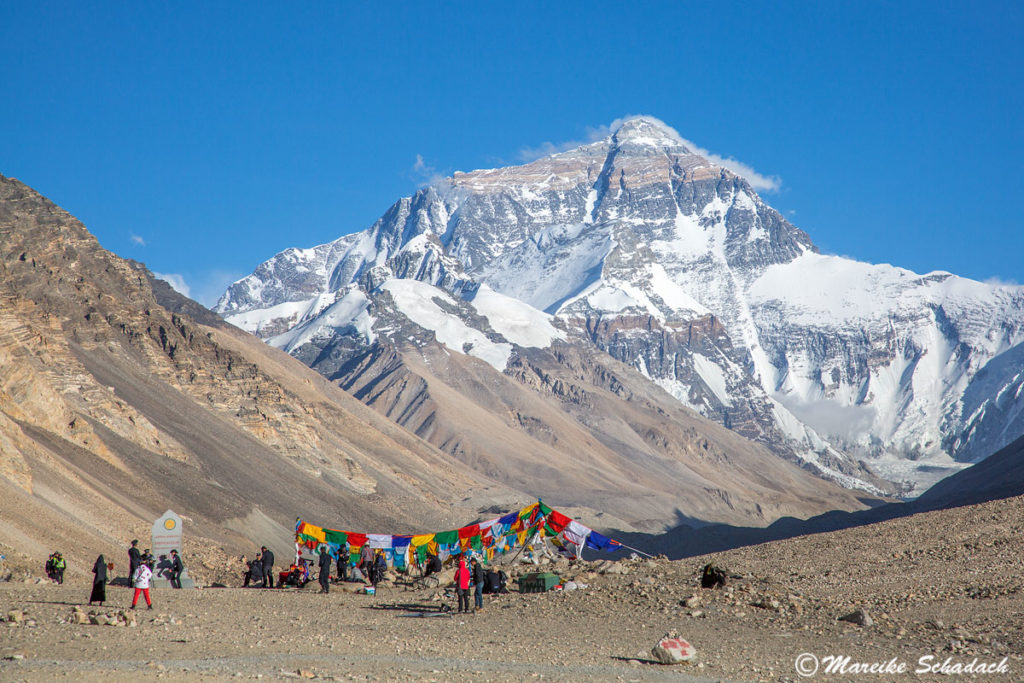
Dratun Monastery
Built in the 7th century, the small monastery at 4,700 m above sea level, just behind the town of Saga, is a tranquil place. In the forecourt of the monastery there is a picture showing a lying demoness. Buddhist monasteries are painted on the demoness. The Dratun monastery is located at the left knee, the Jokhang temple at the heart of the figure.

Especially impressive, however, was the Chapel of the Protector, with two stuffed yetis (bears) and three stuffed wolves, which are supposed to support the fight against the demons.

Photography in Dratun Monastery
In Dratun, photography was also allowed inside the buildings. There are many mystical motifs, especially in the Chapel of the Protectors.


Drive from Saga to Lake Manasarovar
We follow the road from Saga to Lake Manasarovar across the Tibetan plateau. Meanwhile we see herds of yaks and crooked wire fences that keep the yaks off the road. Behind the pass more and more sand dunes are spreading out. The landscape is barren, only a few tufts of grass grow between the stones and sand areas. In some places they try to stem the drift of the sand dunes with stones. Behind the sand dunes and the river Brahmaputra we can see in the distance the Annapurna massif as well as the Machupuchare and the Dhaulagiri. The landscape changes during the further drive to a wide grass steppe where nomads live and graze their flocks of sheep.

Chiu Monastery on Lake Manasarovar
The Chiu Monastery is beautifully located near the holy lake Manasarovar on the top of a small conical mountain. Built in the 8th century, it was dedicated to King Songtsen Gampo, who introduced Buddhism to Tibet in the 7th century.

Hindus believe that anyone who bathes in Lake Manasarovar (Mapam Yumtso) is freed from his sins and also gains good karma. Unfortunately, the Chinese government has prohibited bathing in the lake since 2019. The reason given was the increasing pollution of the water.

Photography at Chiu Monastery
From the mountain you have a great view of the lake. In the distance rises the holy mountain Kailash. Around the monastery, you'll also have plenty of opportunities to take pictures of prayer flags, mani stones, and yak skulls piled up around the stupas.
We even had the opportunity to take pictures inside the prayer hall and chapel. Here you can sometimes see a footprint of Buddha, statues, murals, and bookshelves reaching up to the ceiling.

Tashilhunpo Monastery
Tashilunpo Monastery was built in the 15th century by the first Dalai Lama. Today it is the seat of the Panchen Lama and home to about 600 monks. Tashilunpo also offers most of the religious activities in Tibet and runs its own agriculture for subsistence. After the destruction caused by the Cultural Revolution was repaired and the monastery was renovated, it is also considered one of the most beautiful monasteries in all of Tibet.
The monastery is spacious and has a beautiful interior square surrounded by two-story buildings. The main buildings are lined up in a line on the hill, looking down towards the entrance gate. A posted map leads to the most important places of the monastery. There are several temples to visit, as well as the prayer hall with adjacent chapels.

I found the red Maitreya Temple particularly impressive with the huge Buddha statue in the lotus position. This was built in 1914. It has a strong aura.

The prayer hall, decorated with a golden roof, remained undamaged during the Cultural Revolution, as it was used as a storage room for food. Before the prayer hall was built here, it was a place where air burials were performed. Today many statues with the golden cap of the yellow caps can be seen in the hall. Believers pray in front of the entrance and prostrate themselves. Other believers, mostly women, hurry from sacrificial site to sacrificial site with their butter thermos flasks. There is pushing and shoving.

Between the Maitreya Temple and the prayer hall you can visit the tomb stupas of the Panchen Lama. The stupas were destroyed during the Cultural Revolution. For the 10th Panchen Lama a large golden stupa was newly erected. The remains of the stupas of the remaining Panchen Lamas were combined in a newly erected stupa.
Photography at Tashilhunpo Monastery
The prayer hall is the only place within the monastery buildings where photography is permitted for a fee. But with 150 Yuan it is disproportionately high.
But there are great photo motives during the Kora around Tashilhunpo Monastery, which I can highly recommend.
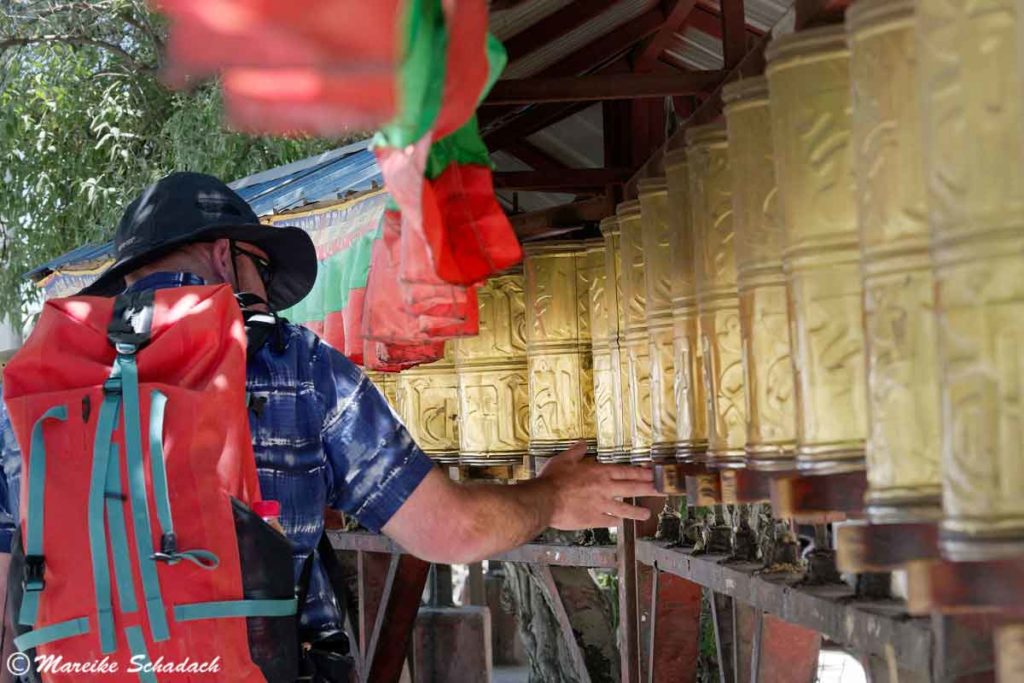
You can find the proper travel backpack, sun hat or a stylish outdoor shirt at Globetrotter*.

Kora around Tashilhunpo Monastery
A Kora around the grounds of Tashilunpo is extremely popular. We follow an approximately 3.5 km long pilgrimage path, which is lined with prayer wheels along almost its entire length. It leads up the hill behind the monastery, from where you have a great view over the city. In the shadow of the prayer wheels dogs and sheep doze. There is even water and food bowls for them under the prayer wheels.

Ganden Monastery - a worthwhile Day Trip from Lhasa
About an hour's drive from Lhasa lies Ganden. Photogenically, it nestles against a mountain slope at an altitude of 4,300 metres. A narrow pilgrim path around the monastery brings you to breathtaking viewpoints over the Kyi-Chu Valley. A day trip from Lhasa to Ganden Monastery is even doubly worthwhile: in addition to the monastery and pilgrim path, which is well worth seeing, you will also receive good altitude training. For Ganden is at 4,300 metres over 600 metres higher than Lhasa. Here you can read what you can see during your visit to Ganden and where you can take the best photos
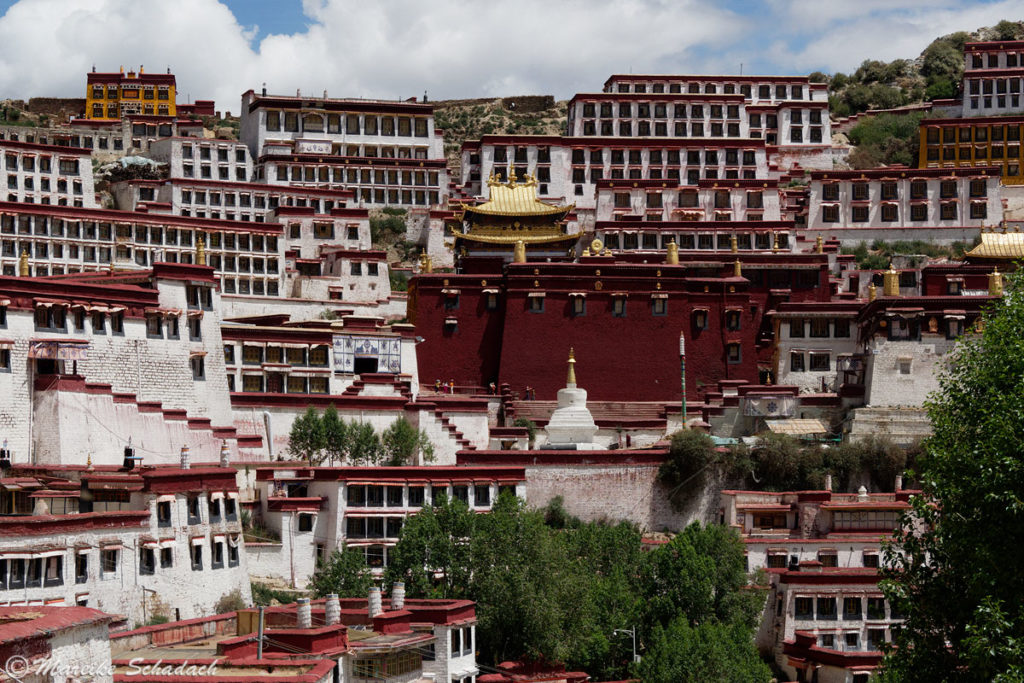
Drak Yerpa Rock Monastery near Lhasa
Since the rock monastery Drak Yerpa was founded in the 7th century, about 10,000 ascetics, monks and scholars have meditated in the caves. Among them were celebrities like Guru Rinpoche, Atisha and King Sogtsen Gampo. Drak Yerpa is one of the holiest rock monasteries in Tibet.

However, the caves were severely damaged during the Cultural Revolution and many statues were destroyed. Ruins of destroyed houses can still be seen. Some monks have since returned. However, their stay in the caves for meditation is now only allowed with prior permission from the government and is limited to 30 to 40 monks.

Drak Yerpa is beautifully situated on the mountain and is ideal for a day trip from Lhasa. Because of the location on the mountain and the many stairs it is strenuous but very worthwhile. There is a simple restaurant next to the parking lot, but the food is not very recommendable.
Photography in Drak Yerpa Rock Monastery
Photography in the different caves was allowed without additional fee. Nevertheless, the monastery is happy about donations.

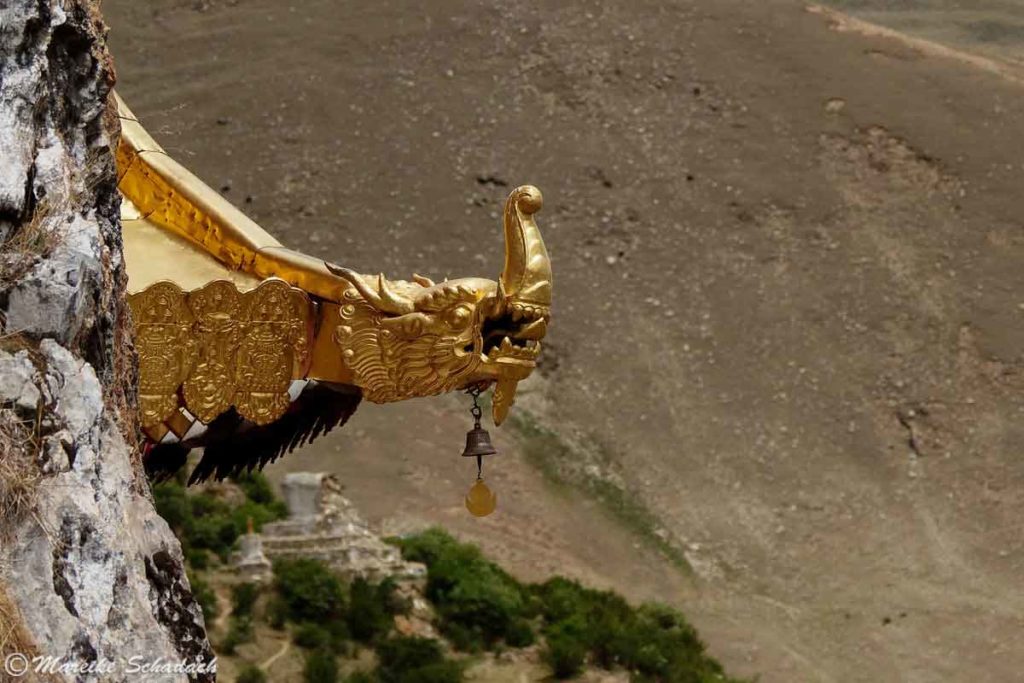

Tip: On the way to Drak Yerpa is also worth a detour to the 3,980 m high and with Prayer flags hung Ngachen La.
Book Recommendations for Tibet
You want to know where the journey goes? Then I can recommend these books* about Tibet.
You can order these books at Amazon with a click on the pictures. If you buy a product via one of these affiliate links, I get a small commission and you help me to keep filling Fernweh-Motive with interesting articles. The product will not be more expensive for you.
Have you ever been to Tibet yourself and explored the monasteries on the roof of the world? How did you like it? Do you have any questions about my article or suggestions? If so, please write me a comment!
Do you want to know when there are new articles on my blog? Then follow me on Facebook, Pinterest or Instagram. I would also be very happy if you share my article with your friends.
